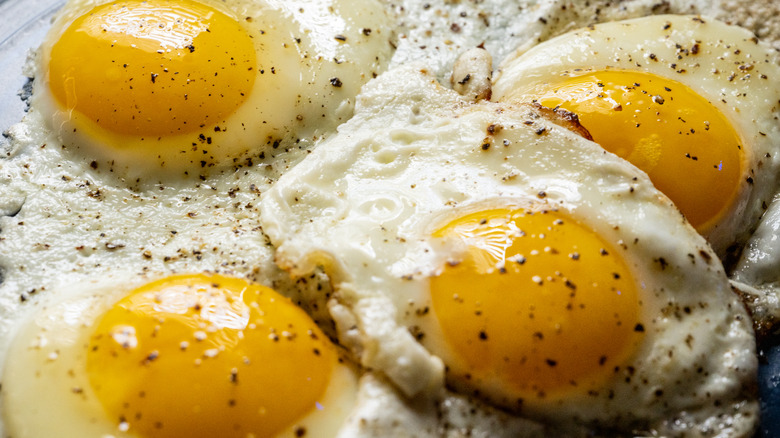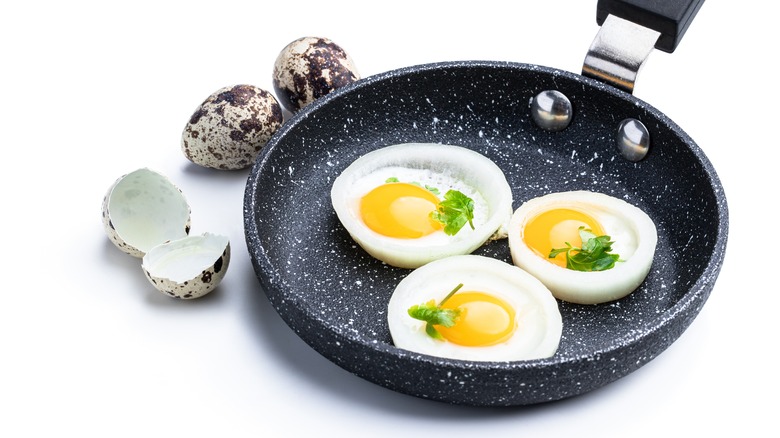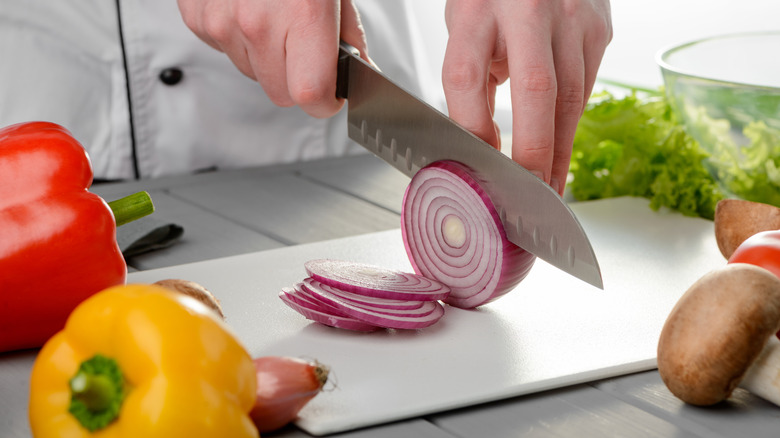The Veggie Trick To Prevent Your Fried Eggs From Spreading
A perfectly fried egg is like watching the sunrise from a beach in Mexico: mesmerizing. Whether you use that beautiful egg to top a bowl of kimchi fried rice, in chilaquiles, or simply serve it up on a plate next to a pile of crispy bacon and a stack of toast — which will naturally be used to dip into the runny yolk — the last thing you want is an ugly fried egg to ruin your picture-perfect meal. But while frying an egg may sound easy enough, often the white will spread out in the pan in an unflattering way. And the problem doesn't stop at an egg that's not quite as attractive as you might like, it can lead to an unevenly cooked one as well.
Allrecipes explains that the different parts of the egg cook at different rates, with the white getting done faster than the yolk. If not fried properly, your egg whites could turn out rubbery and overdone while you wait for your yolk to cook up to your liking. Bon Appétit describes the ideal fried egg as having a warm yolk that spills out when punctured, with a set egg white and crispy, crunchy edges. So, what's the best way to get a fried egg that's both nicely shaped and perfectly cooked? The secret may lie with a vegetable you likely already have in your kitchen and might have been planning to include in your meal anyway.
One vegetable ring to rule them all
Whether you're trying to take Insta-worthy photos or concerned about even cooking, look no further than an onion or bell pepper to help you achieve a perfect fried egg (via Insider). For a round fried egg, an onion is best, while a bell pepper will deliver a slightly irregular, but still pretty — and evenly cooked — egg. Simply slice the vegetable of your choosing into rings and you're ready to get cracking.
Though not perfectly round, the bell pepper ring will give your meal a small boost of vitamin C, per WebMD, and comes with the bonus of an additional pop of color. According to Hunter Lab, this could make your dish more appealing, as people tend to prefer colorful food.
And if you're looking for a fun take on the onion option, home cook and blogger Simple Comfort Food suggests using a fried onion ring instead, which could be made fresh or leftover from last night's dinner. If you opt to use a leftover onion ring, just make sure you crisp it up before adding your egg so you don't end up with a soggy, lukewarm ring.
Tips for getting the perfect vegetable ring
Insider recommends using a ½-inch slice from the veggie of your choosing. To cut an onion into rings, use a knife to slice the allium across its width and then simply separate it into individual rings. The larger rings will be better for larger eggs, like those from a duck, while you can use the smaller interior ones if you're frying up itsy-bitsy quail eggs. To keep the onion from moving around while slicing, EatingWell suggests you create a small flat spot on one side. While this will impact a few of the exterior rings, the interior ones will remain intact.
Bell peppers can be sliced in a similar manner, laying the vegetable on its side and slicing across the width. Since peppers are not round, they are less prone to rolling and you probably don't need to shave any off to create a flat side.
Once you have your perfectly sized vegetable ring selected, you'll want to slide it into the skillet to begin cooking (that is, unless you're a big fan of raw onion or pepper in your food). If you're using pepper rings for your fried eggs, blogger Cool Bean Cooking recommends cooking the veg for about three minutes or so over medium heat before turning the pepper rings over and cracking an egg into each one. Feel free to season your perfect fried egg with salt and pepper and garnish it with some fresh herbs before digging in.


